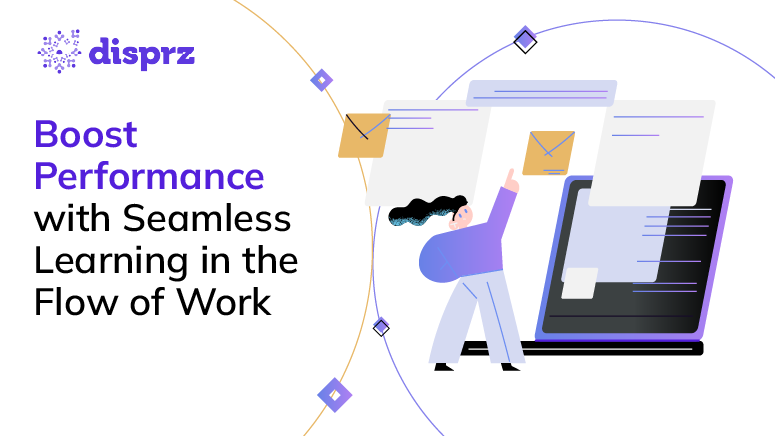Many employees face a lack of learning opportunities to tackle performance challenges, while others with such chances find it hard to squeeze out time from their hectic schedules for learning and development programs.
Surprisingly, studies reveal that most employees can only spare about 24 minutes for learning. That is why, facilitating learning in the flow of work is crucial. This necessary L&D strategy not only provides employees with learning opportunities but allows them sufficient time to engage in the learning process.
What is Learning in the Flow of Work?
"Learning in the flow of work" integrates learning seamlessly into employees' daily tasks, providing access to training content precisely when needed. By incorporating learning into the workflow, employees can apply new knowledge immediately without interruption, enhancing effectiveness. This approach fosters higher engagement with training, boosts productivity, and maximizes the return on training investments. It ensures that learning is not a separate activity but an integral part of the work process, promoting continuous skill development and performance improvement. As a result, employees can acquire and apply knowledge efficiently, leading to better job performance and organizational success. This strategy aligns learning with the demands of modern workplaces, where agility and adaptability are essential for staying competitive in a rapidly changing environment.
4 Benefits of learning in the flow of work
Learning in the flow of work refers to the process of acquiring new knowledge or skills while performing job-related tasks. This approach to learning has gained popularity in recent years due to its numerous benefits.
Here are some of the top advantages of learning in the flow of work:

1) Increase Employee Productivity
Employees are more likely to retain information when they learn in the context of their work. As a result, they can apply what they learn immediately to their tasks, leading to increased productivity.
2) Provide Learning Flexibility
Learning in the flow of work allows employees to learn at their own pace and on their own time. This flexibility makes it easier for employees to balance their work and learning.
3) Improve Employee Engagement
When employees have opportunities to learn and develop their skills, they are more engaged and motivated in their work. Learning in the flow of work can help employees feel valued and invested in their jobs.
4) Increase Employee Retention
Learning in the flow of work encourages employees to apply what they have learned immediately to their work. This practical application of knowledge makes it easier for employees to retain what they have learned.
4 Strategies to facilitate learning in the flow of work
Facilitating learning in the flow of work is the optimal way to enhance your employees’ skills without disrupting their workflow. Check out these 4 strategies for promoting learning in the flow of work. Implementing these strategies is sure to provide your employees with the necessary learning and development trends to foster their growth and positively influence your business outcomes.
1) Embrace the power of microlearning
Microlearning blends well with the learning in the flow of the work environment; the bite-sized content is easy to digest and is less time and resource-intensive.
Microlearning makes the transfer of learning 17% more efficient and produces 50% more engagement with employees.
This skill-based approach is an ideal way to quickly find answers to specific problems that arise during work. It is a perfect fit in a fast-paced work culture as it delivers small morsels of knowledge in real-time at the point of need. High-quality and interactive microlearning modules can capture interest and engage your employees.
2) Leverage mobile learning technology
Mobile learning is another powerful approach that supports learning in the flow of work. It checks all the boxes of benefits, from learning flexibility to improving efficiency. Mobile learning is not only beneficial for employees, but it also helps companies in improving their business outcomes.
43% of learners see improved productivity levels compared to non-mobile users.
Through self-paced mobile learning, employees can easily learn new skills at any hour of their day to improve their performance and contribute to the business's revenue growth.
3) Employ a centralized content repository
For the easy adoption of learning in the flow of work, it is pivotal to have a centralized repository that employees can effortlessly access at any hour of the day. Content that is curated and streamlined on one learning platform is easy to use and even easier to access. Leveraging modern learning technology, like a learning experience platform, ensures the content is streamlined and is powered with a smart AI to suggest relevant content to the employees.
4) Gamify the learning experience
Sometimes work gets too serious and tedious. A pinch of fun is necessary to spread enthusiasm at work. Adding a gaming element to L&D encourages employees to make learning a part of their everyday work. In fact, 89% of employees claim that if a task is gamified, they feel more eager to complete it.
Gamification helps in creating a more interactive learning experience and improves learner engagement. With gamification, can create quizzes and polls to engage employees. Through leaderboards, you can motivate employees to walk the extra mile and put in more effort.
Drive business outcomes with learning in the flow of work
Learning in the context of work has the potential to elevate your employees’ performance to new heights. To make this happen, it’s crucial to offer your employees the right learning environment, tools, and resources. Additionally, you should measure the effectiveness of your learning initiatives using insightful analytics to enhance employee development and skilling.
Disprz is a complete skilling suite enables you to embed learning in the flow of work. See a preview to learning experience Disprz in action









